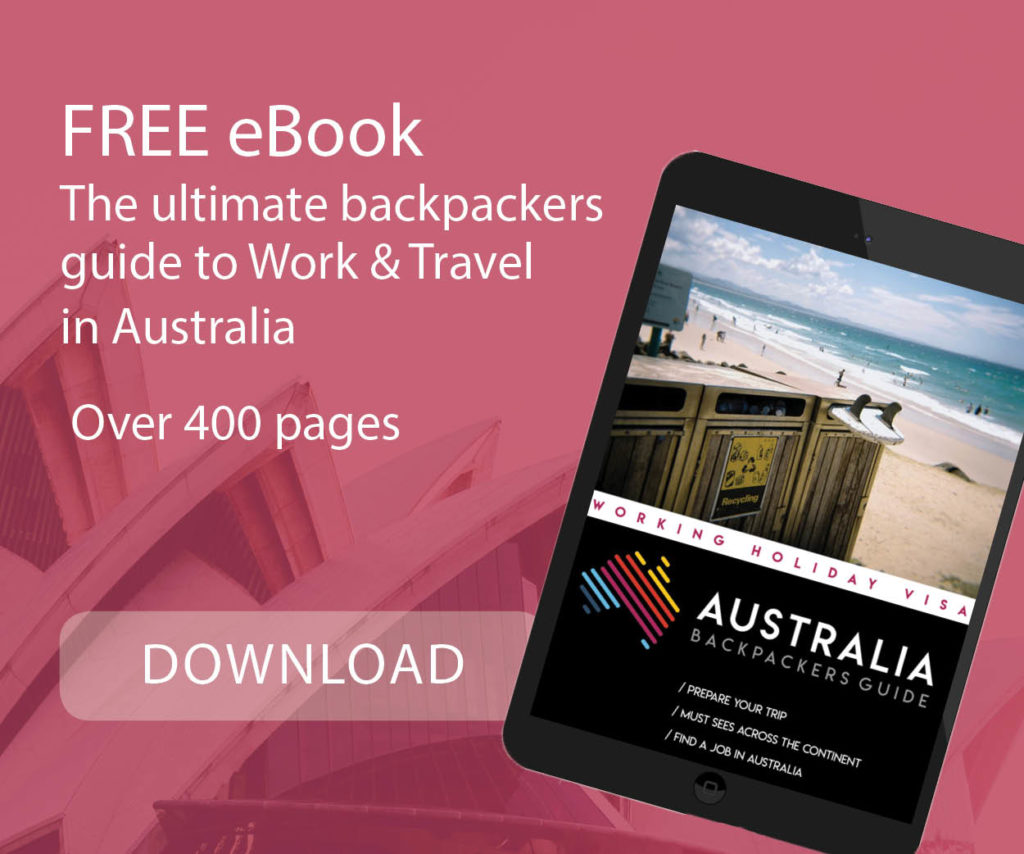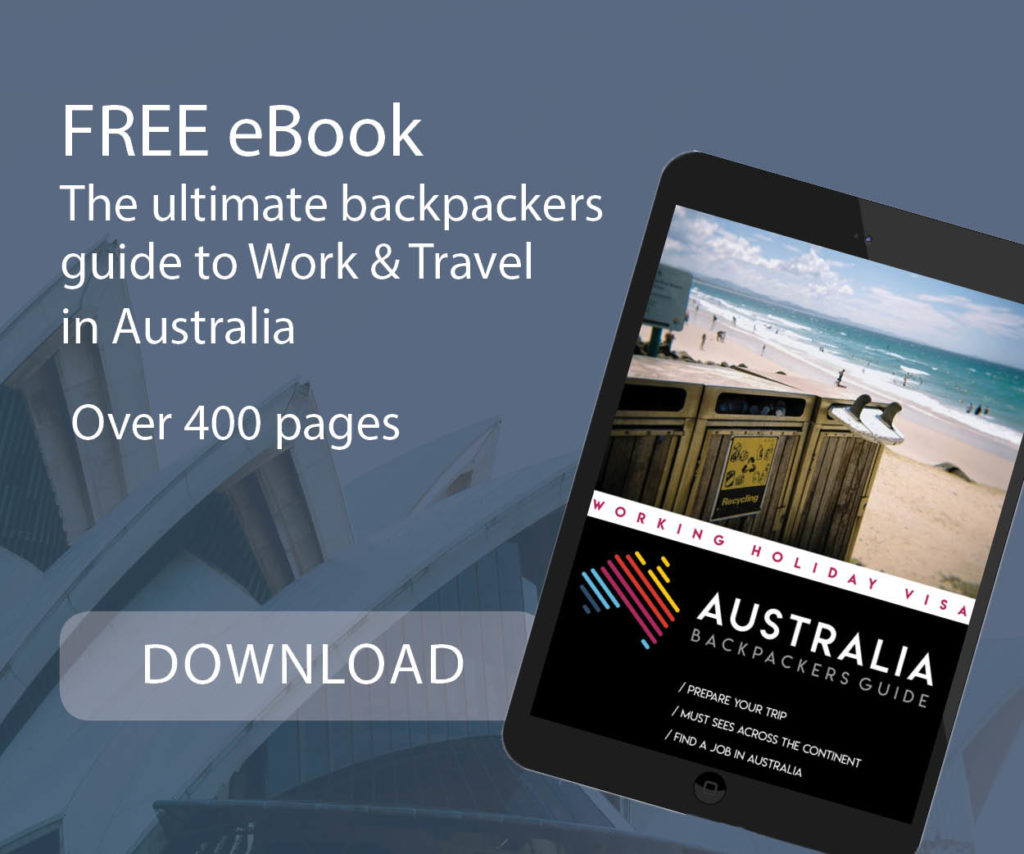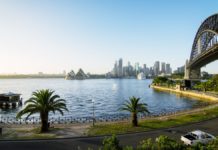
Due to the vastness of the country, the climate in Australia varies greatly from region to region. Sydney, the vibrant capital of New South Wales, enjoys a temperate climate with warm summers, cool winters, and a moderate amount of rainfall spread throughout the year. This makes Sydney a fantastic destination to visit at any time, with each season offering its unique charm and array of activities. Here’s a detailed look at the climate and seasons in Sydney, helping you plan your visit to this iconic Australian city.
Table of Contents
The climate in Sydney
Due to Sydney’s geographical location in the southeastern part of the country, the city enjoys a mild climate throughout the year. Unlike the North of the country with two seasons, the dry season and the rainy season, Sydney has four seasons. The seasons are, however, reversed compared to those in Europe.
The city enjoys more than 300 days of sunshine a year, with an average of 8 hours sunshine a day all year round.
| Season | Months | Average High/Low (°C) | Rainfall (mm) | Daylight (h) |
|---|---|---|---|---|
| Summer | Dec–Feb | 26 / 19 | 120 (total) | 14 – 14.5 |
| Autumn | Mar–May | 23 / 16 | 100 | 11–13 |
| Winter | Jun–Aug | 17 / 9 | 70 | 10–11 |
| Spring | Sep–Nov | 22 / 14 | 90 | 11–13 |
Why Sydney’s Climate Matters in 2025
- Comfortable Year-Round: Mild winters, warm summers—perfect for beach days and city exploring.
- Seasonal Variability: Rainfall peaks in late summer; spring and autumn offer lowest humidity.
- Climate Trends: 2024 saw slightly higher average summer maxima (+0.5 °C) and drier winters than the 30-year norm (1991–2020)¹.
¹ Bureau of Meteorology, Climate Averages for Observatory Hill, Sydney.
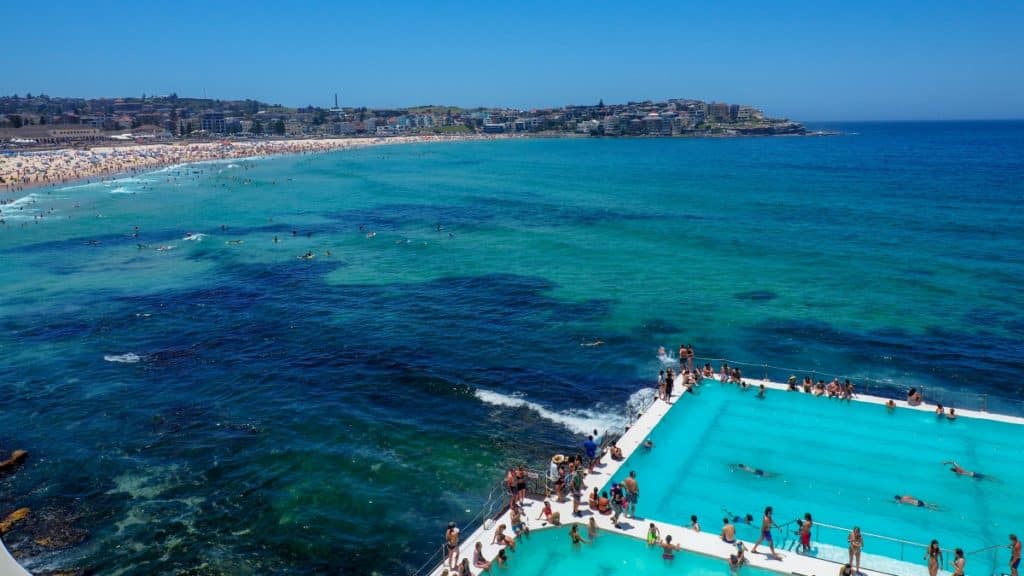
🚐 Cheap Campervan Rental
All our tips & tricks for renting a cheap campervan in Australia! Practical hacks, online comparison sites, promo codes, and more.
Best season to visit Sydney
The best season to visit Sydney is Spring, from September to October as the temperatures are mild and you can expect sun-filled days. However, this season is also perfect because you will avoid the crowds of tourists and Australians who congregate during the Summer and school holidays. This period is ideal to visit the many city museums, go for walks , visit the zoo or discover the many shops in Sydney.
If you want to enjoy the outdoors, either swimming, visiting the beaches and picnics in the park, it’s best to visit Sydney in Summer. During this time, there is little risk of rain (except the odd thunderstorm) and you can spend your days discovering Sydney Bay and the many beautiful beaches around the city. However, when peak Summer hits during the school holidays, expect crowds of people, especially in the famous tourist spots.
For swimming, Bondi Beach is one of the most famous beaches in the city, especially in Summer when the water is hot enough. Between January and March, the water temperature averages 24 ° C.
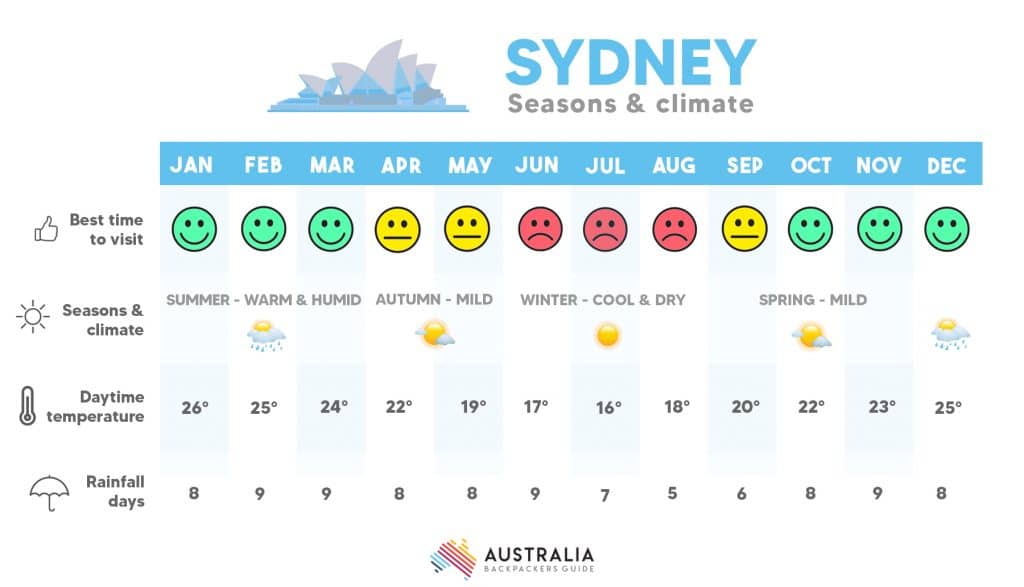
Seasons in Sydney
Winter (June to August) in Sydney is mild compared to many other parts of the world, with temperatures rarely dropping below 5°C (41°F) at night and daytime highs usually between 16°C to 19°C (61°F to 66°F). Snowfall is unheard of in the city, though the nearby Blue Mountains may receive a light dusting. Winter is the driest season in Sydney, making it ideal for exploring outdoor attractions without the summer crowds. It’s also a great time for whale watching, as humpback whales migrate along the coast.
Spring (September to November) brings a rejuvenation of the city’s flora, with temperatures gradually warming to between 11°C to 23°C (52°F to 73°F). Rainfall is moderate, and the weather is generally pleasant, making it a fantastic time for outdoor activities. The season kicks off with the colorful blooms of the Kings Cross Festival and the start of the outdoor market season. Spring is also when the jacarandas bloom, turning the city streets into a sea of purple.
Summer in Sydney is characterized by warm to hot temperatures, with average daytime highs ranging from 25°C to 30°C (77°F to 86°F). However, it’s not uncommon for temperatures to soar above 30°C during heatwaves. The summer months also bring the highest humidity levels of the year, alongside occasional rainfall and thunderstorms. Despite this, summer is a popular time for beachgoers, with iconic beaches like Bondi and Manly bustling with locals and tourists alike. Outdoor festivals, open-air cinemas, and numerous sporting events, including the Sydney to Hobart Yacht Race, make the most of the warm weather.
Autumn (March to May) sees a gradual cooling from the hot summer months, with average temperatures ranging between 14°C to 22°C (57°F to 72°F). This season is often considered one of the best times to visit Sydney due to its mild weather and lower rainfall compared to summer. The city’s parks and gardens, such as the Royal Botanic Garden, are particularly beautiful as the leaves change color. Autumn also hosts the Sydney Royal Easter Show, one of Australia’s largest events.

Monthly Highlights & Tips
December–February (Summer)
- Heatwaves: Occasional days above 35 °C—check BOM heat alerts.
- Free Activities: Dawn dip at Bondi; coastal walk to Bronte before crowds.
- Pack: Light layers, reef-safe sunscreen, wide-brim hat, refillable bottle.
March–May (Autumn)
- Best Window: Mild temperatures, low humidity—ideal for Harbour Bridge climb photos.
- Free Activities: Picnic under jacaranda blooms in the Royal Botanic Garden (Oct/Nov peak).
- Pack: Light jacket for evenings, comfortable walking shoes.
June–August (Winter)
- Chilly Mornings: Expect 6–8 °C pre-dawn—dress in layers for sunrise at Mrs Macquarie’s Chair.
- Rainfall: Short, sharp showers; perfect for museum hopping (Art Gallery, Powerhouse).
- Free Activities: Sunday jazz at The Rocks – outdoor terrace (weather permitting).
September–November (Spring)
- Kick-on Season: Warm days, cool nights—peak outdoor-dining weather in Surry Hills.
- Free Activities: Sculptures by the Sea in Bondi (mid-Oct to early Nov).
- Pack: Mid-weight jumper, light scarf, antioxidant face mist.
Free & Low-Cost Weather-Based Activities
- Coastal Walks: Bondi→Coogee (6 km) or Manly Island loop—free, year-round, ocean views.
- Sunrise on the Harbour: Mrs Macquarie’s Chair or Barangaroo Reserve—no cost, unbeatable vistas.
- Botanic Gardens & Parks: Clyde Warren Park playground, Observatory Hill for summer stargazing.
- Markets: Paddington Markets (Sat) and Glebe Markets (Sun)—open-air, rain or shine.
FAQ Weather in Sydney
Sydney is in the UTC + 10 time zone in Winter and UTC + 11 in summer. The state of NSW applies Summer/Winter time changes, so the time difference between Paris and Sydney changes during the year.
The days are longest in summer. In December, the sun rises around 5:30 am and goes down around 8 pm. In June, (the middle of Winter) the days are shorter. Instead, the sun then rises later at around 7 am and sets earlier at 5 pm.
In winter, temperatures can drop below 10 ° C. It is especially cool in the early morning and evening, so pack a warm jacket.
Summer is sunny and warm in Sydney. Some days can be hot, VERY hot. Pack light clothing, hat and swimsuit to enjoy Sydney’s beautiful beaches and bay.





